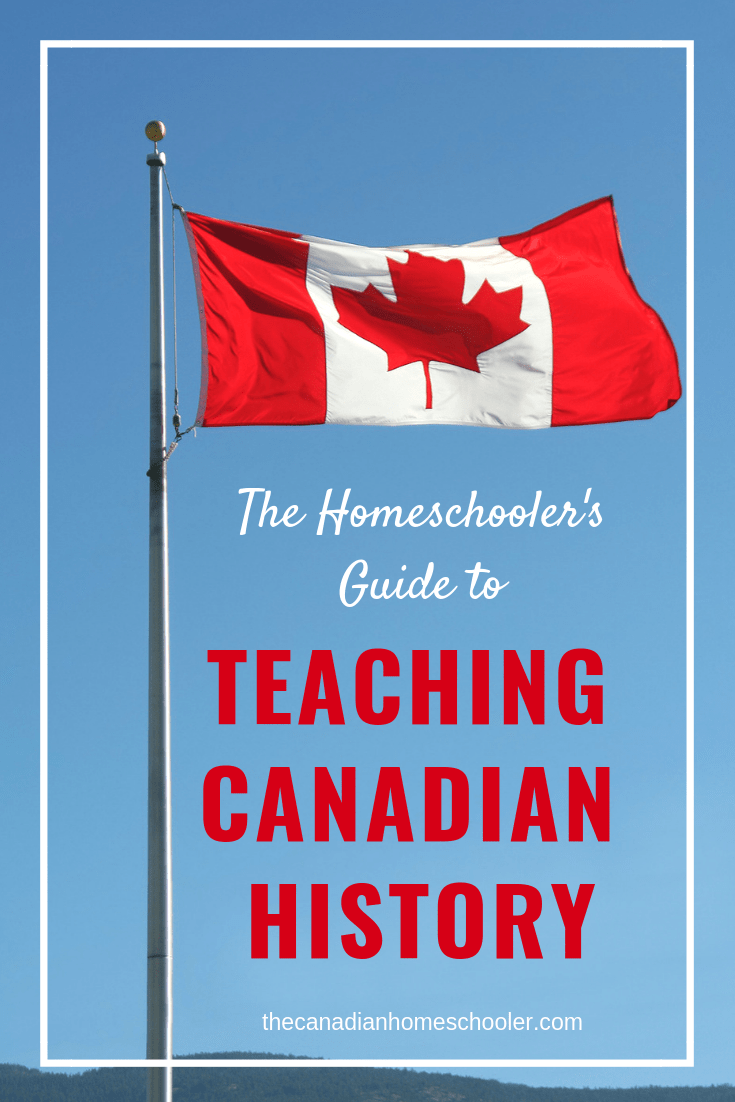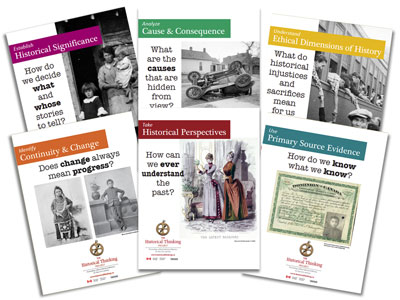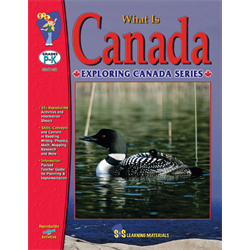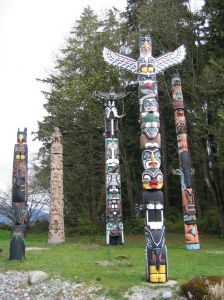Canadian History. This seems to be the one area that homeschoolers in Canada struggle to find quality resources for teaching to their children. We are all trying to figure out the best way to get this information into our kids without making it boring, whitewashed, or overwhelming. This blog post is going to examine the why, how, and what of teaching Canadian history, as well as offer some suggestions on curricula and resources you can use with your children.

This post contains affiliate links.
Why Bother Teaching Canadian History Anyway?
Oftentimes, the first question that comes up around studying history is why? Why should I bother to teach history – it’s old and doesn’t matter anyway about the world right now. There are more exciting things to learn! But there are some really valid and important reasons to study Canadian history.
- A sense of cultural and personal identity
Taking the time to study Canadian history helps us understand why we are who we are. It helps explain the languages that we speak. It explains the reasons that we are different than our American neighbours and the reasons that we are similar. It makes sense of why we use British spelling in many situations. It helps us know why our population is thickest in Ontario and Quebec. It helps us see who we are as Canadians and why we should be proud (or embarrassed) to be labelled as such.
Having cultural pride and identity helps us as a nation, too. The more we understand ourselves and our country, the more we can understand where Canada fits in the overall picture of the world. It teaches us to know how other countries can view us and if they respect us or not.
- Why things are the way things are & an appreciation for today
Learning about the past is important because it gives us a new appreciation for the life we have today. Seeing how far our world has come in the last 10, 50, 100, or 1000 years can be mindblowing. Our lives and experiences today are so completely different than that of people who lived here when Canada became an official country. Understanding that can really help us value the situations in our lives. Plus, it encourages the development of progress – seeing how things are moving forward and how we can be inspired to create and invent amazing new things!
- A new viewpoint
Studying history isn’t just about ourselves. It’s about learning empathy and how to examine experiences from someone else’s eyes. It’s an opportunity to see how events influenced other cultures and communities – and what impact that has had on them throughout the years up until today.
- Learning from Past Mistakes
History is far from perfect – so how can we learn from the past and make sure horrible things don’t happen again? How can we be different today? Can we see things that are similar to experiences of the past and catch them before they get to a bad place? Can we see patterns in our history that need to be broken? History can teach us how we as people tend to shift our eyes from one group of people to another and treat them unfairly – is there a way we can learn from this to make a change?

Six Historical Critical Thinking Concepts to Consider While Teaching Canadian History
History has often been presented as a series of facts in a textbook. But it’s important for us not to just take what we learn at face value, but to think critically and logically about how things are presented. We need to be historical detectives to see if what we are learning is the truth. Canadian Professor Seixas and Ms. Colyer put together the Historical Thinking Project – which outlined six important things to consider when it comes to studying Canadian history. These are applicable to so many areas of study, but especially that of history.
1 – Historical Significance
This concept asks us to consider what significance does this moment have in overall history? Did it make a major change? Did it influence or have a meaningful part in the story of the world? What value does it have to the big picture? Remember – the concept of Important can be different for various people and even change over time.
2 – Primary Source Evidence
Primary sources are resources that are directly from the people involved in the moment of history being examined. Kind of like a murder investigation – these make up the first-hand evidence to examine more closely to get a clearer idea of the who, what, why, how, and when about that moment in history.
It is the photographs, videos, letters, first-hand accounts, documents, newspapers, birth, death, and marriage records, and other scraps of recorded history that can make up a collection of primary sources. These provide a first-person view of their experience and allow us to piece together a better picture. We need to ask ourselves who made this and why? When did they do it – was it right after the event happened or 50 years later? What was their viewpoint or how were they influenced (such as their faith or cultural bias)? Does it cross-reference with other evidence?
Facts aren’t always true. Go the Source. (This is applicable in so many areas of our lives!)
3 – Continuity and Change
This step helps us consider how the moment of history we are looking at fits into the context of the big picture of history. What was going on around the same time? How were things changing and how were things staying the same?
4 – Cause & Consequence
In this step, we’re trying to figure out why did this happen? What caused this event or experience? What impact did it have? Think of the political, societal, economic, and cultural changes that happened because of this event. Also, think on a personal level how it would have impacted the people involved and what kind of ripple effect that could have. Looking at these details, take a minute to consider a pivotal moment and what could have changed this event or stopped it from happening?
5 – Historical Perspectives
One of the biggest struggles with studying history is to not use our own viewpoints and current perspectives to look at a moment of history, but instead to put ourselves in the thoughts and viewpoints of the period of time in which they happened. We need to consider the worldview at the time. How were they influenced? What the general society believe and fight for? How did they view other cultures, other genders, other beliefs? What did they value? What was considered proper and right and what was considered scandalous? Taking all of these into account before looking at a moment in history can really help us better understand the why and what behind that experience.
Also… think of things from different groups of people. Children would have a different viewpoint than adults. People who were held as slaves would have different viewpoints than their masters. Indigenous people would have different viewpoints than European colonials. French Catholic settlers would have different viewpoints than those of the British Protestants.
How can we see through their eyes?
6 – Ethics
Ethics is a tough one. How can we judge things of the past fairly, given that the experience then is not from the same as it is now? Are there people and moments that we should consider wrong, and if so, how does that affect our study of that? Having informed judgments of the past can really help us be better today. Questions to ask are “What can we learn about from this historical moment?” and “how does this help us understand ourselves today?”
Want to learn more about the Six Historical Thinking Concepts? Professor Seixas co-authored a detailed book called, The Big Six.
The Lie That We Tend To Believe About Canadian History
If I was to ask you to give me a moment of history that was amazing or interesting or exciting – what would you say? Chances are it wouldn’t likely be something that happened in Canadian history. That’s because, for many people, Canadian history is considered boring. There are some good reasons for that – like how it is often presented in school, just as a series of dates and facts or that we don’t have any flash-bang! moments to back upon for interest. Canadian history is much more subtle. Instead of just being able to ramble off events on a timeline – our history needs to be taught in a much more personal way.
On the big timeline of history, Canada has only really had a recorded history that is quite short. It doesn’t have any major events or special features that draw attention to it on a grand scale, so it’s easy to figure it isn’t fun or important. To study Canadian history and make it more exciting, we need to zoom in closely and narrow our focus to the people and specific moments of our story.
If you, as the parent/teacher, find Canadian history boring, what can you do? How can you change that mindset?
- Start with historical fiction. In particular, read some books written for youth and tweens. These books are typically not too hard of a read and don’t require large commitments of time, and are fast-paced, which helps keep your attention. They grab hold of a moment in history and bring it alive so it becomes exciting. Need some book ideas? Check out this list of Canadian historical fiction.
- Watch some documentaries. Resources like the National Film Board and the CBC offer some great collections of documentary and interesting videos on history.
- Watch historical fiction based on moments of Canadian history. Again, making it into a story instead of set of facts and data can really pique a person’s interest. Here are some lists of movies to consider. (Disclosure: I haven’t seen all of these videos so I cannot offer advice on what each is like.)
- Watch the Heritage Minutes and find something there that you can get curious about. (There are even some hilarious parodies which might be a fun way to start!)
Making Teaching Canadian History Fun
As with all things that we teach our children, it’s important to find a way to make that subject understandable, engaging, and maybe a little exciting. History is no different – and, despite the fact that too often our own experiences are lacking, there are actually a lot of fun ways to enjoy teaching Canadian history.
- Get closer to the action than a wide overview. Realizing that we don’t have the same monumental events and long history to draw from, instead, we need to zoom in on the moments, the places, and the people of specific parts of our story. Get closer to the action than a wide overview. Pick moments and learn about that instead of a grand arching overview.
- Role model positivity and engagement to our kids. Be excited and inspire curiosity for our kids.
- Learn about people. Kids want to know about the people who experienced that moment in history. They want to see how different and how the same they are to those people. They want to imagine themselves in that person’s shoes and relate to their experience. This is a great reason to use historical fiction.
- Have a variety of activities. Use lots of different opportunities for learning – and not just what you are tempted to default to. Sure, use a textbook, a video, a living book – but don’t be afraid to think outside the textbook. Make something. Craft something. Draw something. Bake something. Write something. Go somewhere. Talk to someone. Re-enact something. Play a game.
- Make it personal. If there is a way to connect your family to a moment of history, share it with your kids. Were there people in your ancestry who travelled to Canada? Were any of your family involved in any of the moments of our history? Learn more about your own family history and see how you can dive in more to Canadian history.
Resources to Help in Teaching Canadian History
Canadian history is one of the subjects that a lot of homeschoolers seem to have trouble finding resources for while searching for a curriculum. Here are some ideas to consider:
CURRICULUM:
- Donna Ward – Donna’s company of Northwoods Press has long been associated with quality Canadian history and geography resources for homeschoolers. The book Courage & Conquest is designed for use in grades 3 to 6 and is very simply laid out to help you navigate the course of our history. Stopping at different moments in history, she guides you to both fiction and non-fiction books to read, clips of videos to watch, a timeline to add to your wall, short reading passages, and worksheets. Also available is a high school course.

- Canadian History Task Cards – From Creek Edge Press – For this program, you print out a set of weekly task cards. These cards include all sorts of tasks for your student to complete about a moment in our history.
- Modern History Through Canadian Eyes – Using the Story of Canada by Janet Lunn as a spine, this program is more of a guide to studying history, combining readings with activities and other resources to connect our history with what was happening around the world at the same time.
- Christian Light Education – Canadian Social Studies: A workbook-based learning program for both elementary and middle school years, this series includes vocabulary, reading articles, and worksheet activities such as fill-in-the-blanks and matching.
- Creating History – a high school study of modern Canadian history.
- The Great Canadian Adventure – a monthly subscription program that sends you a province by province history curriculum, combining reading, research, and smashbook creation.
- My Canadian Time Capsule – From The Canadian Homeschooler, this is a monthly membership Canadian history unit study that stops at various moments to dive in deeper through a collection of varying activities that change based on the topic being looked at: videos, online games, mapping, art, writing, crafts, experiments, music, books, cooking, games, and more.

- Headphone History – an audio history of Canada. Listen to the stories of Canada’s past, combined with matching worksheets.
HISTORICAL FICTION BOOK LISTS
- Canadian History Living Books List
- Great Books to Study Canadian History – By Bonnie Landry. A Detailed list with summaries and more information about different books of Canadian history.
INDIGENOUS LEARNING RESOURCES
- Indigenous Perspectives Education Guide from Historica Canada
- Strong Nations – an Indigenous bookstore
- Speaking Our Truth: A Journey of Reconciliation
- The Indian Residential Schools and Reconciliation Teacher Resource Guides – for grades 5, 10 and 11/12
- Project of Heart – Lesson Plans
WEBSITES WITH LESSON PLANS
These aren’t complete curriculum resources, but offer lesson plans on specific topics or moments of history. Keep in mind that these are generally designed for classroom use and might need adapting to be used in a homeschool setting.
- Historica Canada – Includes the “Think Like An Historian” series
- MysteryQuests – For ages 11-18, these lessons are detective work to figure out what students can learn about the mystery
- Canada’s History
- Canada: A People’s History – Worksheets and Printables to go with the video series (grade 5-9)
- Black History Canada
- Historical Thinking
- The History Education Network – Although not so much lesson plans, this website has a HUGE collection of amazing links to resources to help with teaching Canadian history.
- Bamboo Shoots: Chinese Canadian Legacies in BC
CANADIAN HISTORY TEACHERS PAY TEACHERS STORES
- Diana Bailey
- 2 Peas and a Dog
- Light Up Learning Labs
- Top Priority Teaching
- Chocolate Covered Classroom Creations
OTHER CANADIAN HISTORY RESOURCES
- Timeline of Canadian History
- 31 Days of Hands-On Canadian History
- Canadian Museum of History
- CBC Digital Archives
So there you have it, the ultimate guide to teaching Canadian history in your homeschool.
Have I missed anything? What resources would you add to this list?
- Homeschool Spelling Essentials: Ways to Make it Engaging (and Canadian!) - October 4, 2024
- 10 Simple Homeschool Organization Tips For Busy Homeschoolers - September 16, 2024
- 5 Ways Homeschoolers Can Enjoy Back to School - September 10, 2024





Of course not. Canadian history is not boring. We should be proud of our diverse rich cultural heritage like any other country. Most importantly we want to focus on the qualities of love , brotherhood n warm feeling that characterizes tthe people of Canada. We should be proud to teach our children all the wise n practical lessons we can learn from the indigenous peoples and the Chinese who worked hard fto make this country a better place. May it be our solemn responsibility to impart these valuable lessons to future generations.
I am interested in picking up a little Canadian history for both myself and my children. We are a US homeschooling family, but with roots in Canada. My paternal grandfather and going back before that were French Canadian. What do you all consider some topics, issues, etc. that would be essential to cover? Maybe part of our topics might be to research and compare/ contrast how Canada and the US handled some of the same things? Where does Canada stand out as being quintessential Canadian – as all countries have that special something?
Hey Crystal,
I’m sure there are lots of great history moments that you might find a good fit and of interest. Most of Canada’s early history is very intertwined with the US, so things like the fur trade and Indigenous history are interconnected. The American Revolution led to the loyalists moving to Canada. The Underground Railroad. Those kinds of things.
One kind of big moment, I suppose, was when the French were defeated by the British in the Seven Years’ War. That kind of changed the direction of our country, but also is one of the reasons that we have a bilingual country today. This list (which is about historical fiction books) might help at least give you topics? https://thecanadianhomeschooler.com/canadian-history-through-living-books/
Looks great. Thinking of picking up a few Dear Canada books. Looks similar to the Dear America series.
Every subject has a base of knowledge that requires memorization, just like a computer needs desktop memory to shuffle things around. The rest can be looked up when needed. No one wants to be operated on by a surgeon who has to consult the anatomy textbook. However, history is so much more than facts and dates. There is tedium in all subjects and a good teacher will reduce the tedium and monotony and help the students to see the relevance of the subject to their daily lives. For example, instead of just learning about Herb Carnegie, how about adding a project that gets the community informed and active behind getting him into the Hockey Hall of Fame? Kids are into action and want to make a difference. It is not the subject itself that is boring, it’s the way it’s presented. There are A LOT of exciting actors in Canadian history; for every Rosa Parks there is a Viola Desmond (who, incidentally, was first). So no, the premise of this site, that the stories of Canadians is boring, which may be a ‘hot take’ to get clicks and eyeballs, is false.
No, the premise of this site isn’t that Canadian history is boring in order to get clicks. I don’t care about clicks. I care about helping people succeed with homeschooling. The “Canadian History is Boring” comment is based on the comments of many people (and my own experience). Despite having hated Canadian history as a student, I’ve learned to appreciate it as an adult and wondered how to take that dry, boring narrative that’s often presented as our history and find a way to make it interesting to our kids. We don’t have the same long, varied history of older countries. We don’t really have any major explosive moments like a revolution or such. We have to do something different. Zooming in close to different people and moments is a great way. Reading historical fiction is another. You are right – it’s the way it’s presented and hopefully there are some ideas here to help people find a way to make it engaging for their kids.